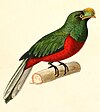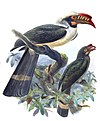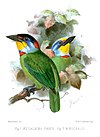
Picinae containing the true woodpeckers is one of four subfamilies that make up the woodpecker family Picidae. True woodpeckers are found over much of the world, but do not occur in Madagascar or Australasia.

A harrier is any of the several species of diurnal hawks sometimes placed in the subfamily Circinae of the bird of prey family Accipitridae. Harriers characteristically hunt by flying low over open ground, feeding on small mammals, reptiles, or birds. The young of the species are sometimes referred to as ring-tail harriers. They are distinctive with long wings, a long narrow tail, the slow and low flight over grasslands and skull peculiarities. The harriers are thought to have diversified with the expansion of grasslands and the emergence of C4 grasses about 6 to 8 million years ago during the Late Miocene and Pliocene.

The lesser spotted woodpecker is a member of the woodpecker family Picidae. It was formerly assigned to the genus Dendrocopos. Some taxonomic authorities continue to list the species there.

Woodpeckers are part of the bird family Picidae, which also includes the piculets, wrynecks and sapsuckers. Members of this family are found worldwide, except for Australia, New Guinea, New Zealand, Madagascar and the extreme polar regions. Most species live in forests or woodland habitats, although a few species are known that live in treeless areas, such as rocky hillsides and deserts, and the Gila woodpecker specialises in exploiting cacti. Woodpeckers are known as the loudest birds of the forest.

The hairy woodpecker is a medium-sized woodpecker that is found over a large area of North America. It is approximately 250 mm (9.8 in) in length with a 380 mm (15 in) wingspan. With an estimated population in 2020 of almost nine million individuals, the hairy woodpecker is listed by the IUCN as a species of least concern. Some nomenclature authorities, such as the eBird/Clements checklist, place this species in the genus Dryobates.
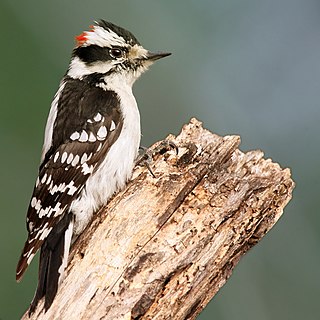
The downy woodpecker is a species of woodpecker, the smallest in North America. Length ranges from 14 to 18 cm. Downy woodpeckers primarily live in forested areas throughout the United States and Canada, with the exception of deserts in the southwest and the northern tundra. The bird nests in tree cavities and feeds primarily on insects, although it supplements its diet with seeds and berries. The downy woodpecker is very similar in appearance to the hairy woodpecker, although they are not closely related.

The black-backed woodpecker, also known as the Arctic three-toed woodpecker, is a medium-sized woodpecker inhabiting the forests of North America.
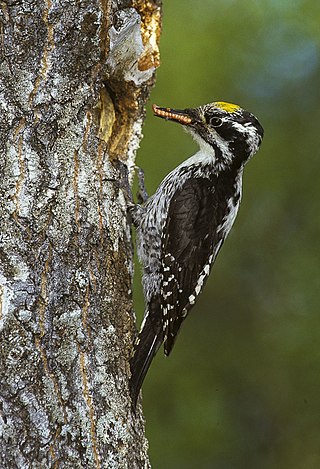
The Eurasian three-toed woodpecker is a medium-sized woodpecker that is found from northern Europe across northern Asia to Japan.

Tyrannus is a genus of small passerine birds in the tyrant flycatcher family Tyrannidae that are native to the Americas. The majority are named as kingbirds.

Milvus is a genus of medium-sized birds of prey. The genus was erected by the French naturalist Bernard Germain de Lacépède in 1799 with the red kite as the type species. The name is the Latin word for the red kite.

Campephilus is a genus of large American woodpeckers in the family Picidae.

Dendrocopos is a widespread genus of woodpeckers from Asia, Europe and Northern Africa. The species range from the Philippines to the British Isles.

The yellow-billed kite is the Afrotropic counterpart of the black kite, of which it is most often considered a subspecies. However, DNA studies suggest that the yellow-billed kite differs significantly from black kites in the Eurasian clade, and should be considered as a separate, allopatric species.

Campethera is a genus of bird in the family Picidae, or woodpeckers, that are native to sub-Saharan Africa. Most species are native to woodland and savanna rather than deep forest, and multiple species exhibit either arboreal or terrestrial foraging strategies. Its nearest relative is the monotypic genus Geocolaptes of southern Africa, which employs terrestrial foraging and breeding strategies. They are however not close relatives of similar-looking woodpeckers in the "Dendropicos clade".
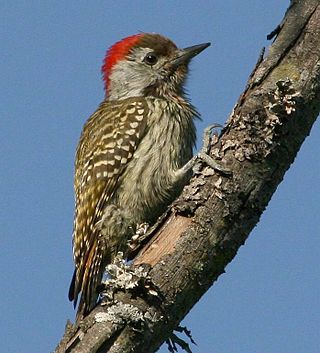
Dendropicos is a genus of woodpeckers in the family Picidae. They are small woodpeckers that are native to the sub-Saharan woodlands and forests.

Ceyx is an Old World genus of river kingfishers. These kingfishers are found from South East Asia to the Solomon Islands.

Leuconotopicus is a genus of woodpeckers in the family Picidae native to North and South America.

Dryobates is a genus of birds in the woodpecker family Picidae. The species are widely distributed and occur in both Eurasia and the Americas.

Yungipicus is a genus of woodpeckers in the family Picidae native to Asia. The species in this genus were previously placed in the genus Dendrocopos.

Dendrocoptes is a genus of woodpeckers in the native to Eurasia.






























